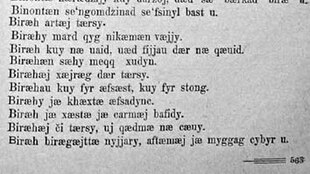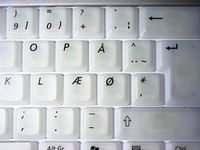Æ
| Æ | |
|---|---|
| Æ æ | |
Latin language | |
| Phonetic usage | [æ, a, i, ɛ, e] |
| History | |
| Development | |
| Other | |
| Writing direction | Left-to-Right |


Æ (
As a letter of the
Languages
Latin
In
French
In the modern
English

In
In the United States, the issue of the ligature is sidestepped in many cases by use of a simplified spelling with "e", as happened with œ as well. Usage, however, may vary; for example, medieval is now more common than mediaeval (and the now old-fashioned mediæval) even in the United Kingdom,[5] but archaeology is preferred over archeology, even in the US.[6]
Given their long history, ligatures are sometimes used to show archaism or in literal quotations of historic sources; for instance, in those contexts, words such as dæmon and æther are often so spelled.
The ligature is seen on gravestones of the 19th century, short for ætate ("at the age (of)"): "Æ xxYs, yyMs, zzDs." It is also common[
In
, "from bronze").In Old English, æ represented a sound between a and e (/æ/), very much like the short a of cat in many dialects of Modern English. If long vowels are distinguished from short vowels, the long version /æː/ is marked with a macron (ǣ) or, less commonly, an acute (ǽ).
Other Germanic languages
In Old Norse, æ represents the long vowel /ɛː/. The short version of the same vowel, /ɛ/, if it is distinguished from /e/, is written as ę.
In most varieties of
- [ɛa] when simultaneously stressed and occurring either word-finally, before a vowel letter, before a single consonant letter, or before the consonant-letter groups kl, kr, pl, pr, tr, kj, tj, sj, and those consisting of ð and one other consonant letter, except for ðr when pronounced like gr (except as below)
- a rather open [eː] when directly followed by the sound [a], as in ræðast (silent ð) and frægari (silent g)
- [a] in all other cases
One of its etymological origins is Old Norse é (the other is Old Norse æ), which is particularly evident in the dialects of Suðuroy, where Æ is [eː] or [ɛ]:
- æða (eider): Southern [eːa], Northern Faroese [ɛava]
- ætt (family, direction): Southern [ɛtː], Northern Faroese [atː]
In Icelandic, æ represents the diphthong [ai], which can be long or short.
In
- /æː/ as in æ (the name of the letter), bær, Solskjær, læring, æra, Ænes, ærlig, tærne, Kværner, Dæhlie, særs, ærfugl, lært, trær ("trees")
- /æ/ as in færre, æsj, nærmere, Færder, Skjærvø, ærverdig, vært, lærd, Bræin (where æi is pronounced as a diphthong /æi/)
- /eː/ as in Sæther, Næser, Sæbø, gælisk, spælsau, bevæpne, sæd, æser, Cæsar, væte, trær ("thread(s)" [verb])
- /e/ as in Sæth, Næss, Brænne, Bækkelund, Vollebæk, væske, trædd
In many northern, western, and southwestern Norwegian dialects such as Trøndersk and in the western Danish dialects of Thy and Southern Jutland, the word "I" (Standard Danish: jeg, Norwegian: jeg) is pronounced /æː/.[9] Thus, when this word is written as it is pronounced in these dialects (rather than the standard), it is often spelled with the letter "æ".
In western and southern
The equivalent letter in German, Swedish, and Finnish is ä, but it is not located at the same place within the alphabet. In German, it is not a separate letter from "A" but in Swedish and Finnish, it is the second-to-last letter (between å and ö).
In the normalized spelling of Middle High German, æ represents a long vowel [ɛː]. The actual spelling in the manuscripts varies, however.
Ossetic

South American languages
The letter æ is used in the official orthography of
International Phonetic Alphabet
The symbol [æ] is also used in the
The Uralic Phonetic Alphabet (UPA) uses four additional æ-related symbols, see Unicode table below.[11]
Cyrillic
The Latin letters are frequently used in place of the Cyrillic
Typing the character

- The HTML entities are
Æandæ - Windows: Alt+0198 or Alt+146 for uppercase, Alt+0230 or Alt+145 for lowercase.
- In the TeX typesetting system, ӕ is produced by
\ae. - Microsoft Word: Ctrl+⇧ Shift+& followed by A or a.
- X: Composeae and ComposeAE can be used.
- In all versions of the Mac OS (Systems 1 through 7, Mac OS 8 and 9, OS X, macOS 11, 12, 13, and the current macOS 14): æ: ⌥ Option+' (apostrophe key), Æ: ⌥ Option+⇧ Shift+'.
- On the iPhone, iPod touch and iPad, as well as phones running Google's Android OS or Windows Mobile OS and on the Kindle Touch and Paperwhite: hold down "A" until a small menu is displayed.
- On US-Internationalkeyboards, Æ is accessible with AltGr+z (X sometimes uses AltGr+a.
- The Þ and Ö).
- The Norwegian keyboard layout also has a separate key for Æ, rightmost of the letters, to the right of Ø and below Å.
- In Vim the digraph is 'AE' for Æ and 'ae' for æ. (Press Ctrl-K in Insert mode.)
Unicode
- U+00C6 Æ LATIN CAPITAL LETTER AE
- U+00E6 æ LATIN SMALL LETTER AE
- U+01E2 Ǣ LATIN CAPITAL LETTER AE WITH MACRON
- U+01E3 ǣ LATIN SMALL LETTER AE WITH MACRON
- U+01FC Ǽ LATIN CAPITAL LETTER AE WITH ACUTE
- U+01FD ǽ LATIN SMALL LETTER AE WITH ACUTE
- U+1D01 ᴁ LATIN LETTER SMALL CAPITAL AE (UPA)
- U+1D02 ᴂ LATIN SMALL LETTER TURNED AE (UPA)
- U+1D2D ᴭ MODIFIER LETTER CAPITAL AE (UPA)
- U+1D46 ᵆ MODIFIER LETTER SMALL TURNED AE (UPA)
- U+1DD4 ◌ᷔ COMBINING LATIN SMALL LETTER AE
- U+10783 𐞃 MODIFIER LETTER SMALL AE (IPA)
See also
Footnotes
Notes
- ^ More information may be found at their entries on Wiktionary (
 ǣ,
ǣ,  ᴂ, etc.), and on the appendix page there entitled
ᴂ, etc.), and on the appendix page there entitled  Variations of ae.
Variations of ae.
References
- ^ Harrison, James A.; Baskervill, W. M., eds. (1885). "æsc". A Handy Anglo-Saxon Dictionary: Based on Groschopp's Grein. A. S. Barnes. p. 11.
- ISBN 978-0-19-860199-9, p. 3
- ^ http://monsu.desiderio.free.fr/curiosites/ligat-ae.html
- ^ https://www.ina.fr/ina-eclaire-actu/video/i04233221/serge-gainsbourg-elaeudanla-teiteia
- ^ The spelling medieval is given priority in both Oxford and Cambridge Advanced Learner's Dictionary. Accessed September 22, 2014.
- ^ Merriam-Webster Advanced Learner's Dictionary. Accessed September 22, 2014.
- ^ Online search, February 2021[permanent dead link]
- ISBN 9781912667352p. xxxv.
- ^ Albert, Daniel (2022-06-24). "Trøndersk: The Dialects of Middle Norway". Life in Norway. Retrieved 2023-10-18.
- ^ Miller, Kirk; Ashby, Michael (2020-11-08). "L2/20-252R: Unicode request for IPA modifier-letters (a), pulmonic" (PDF).
- ^ Everson, Michael; et al. (2002-03-20). "L2/02-141: Uralic Phonetic Alphabet characters for the UCS" (PDF).
Further reading
- ISBN 0-88179-205-5. p. 271.
External links
 The dictionary definition of Æ at Wiktionary
The dictionary definition of Æ at Wiktionary The dictionary definition of Category:English terms spelled with Æ at Wiktionary
The dictionary definition of Category:English terms spelled with Æ at Wiktionary Media related to Æ at Wikimedia Commons
Media related to Æ at Wikimedia Commons

